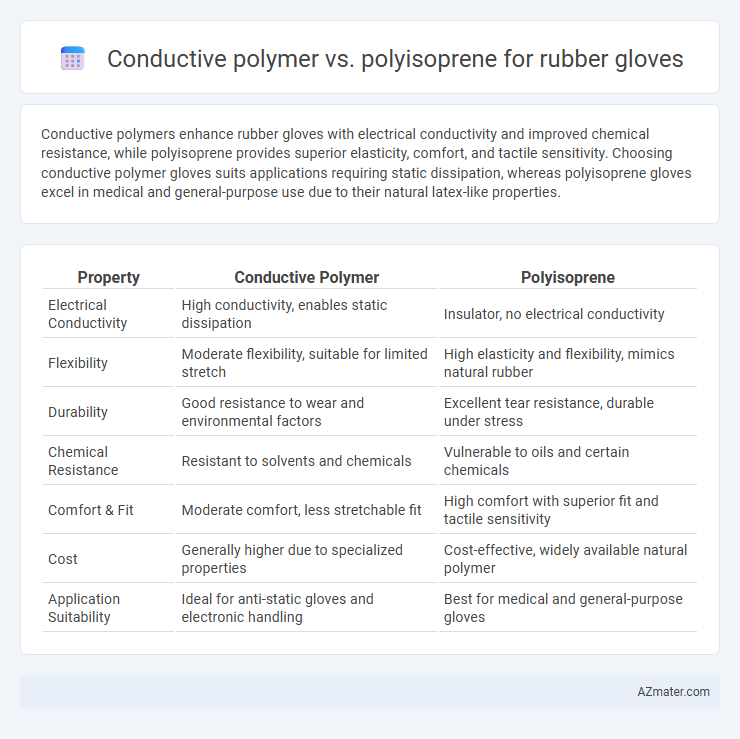Conductive polymers enhance rubber gloves with electrical conductivity and improved chemical resistance, while polyisoprene provides superior elasticity, comfort, and tactile sensitivity. Choosing conductive polymer gloves suits applications requiring static dissipation, whereas polyisoprene gloves excel in medical and general-purpose use due to their natural latex-like properties.
Table of Comparison
| Property | Conductive Polymer | Polyisoprene |
|---|---|---|
| Electrical Conductivity | High conductivity, enables static dissipation | Insulator, no electrical conductivity |
| Flexibility | Moderate flexibility, suitable for limited stretch | High elasticity and flexibility, mimics natural rubber |
| Durability | Good resistance to wear and environmental factors | Excellent tear resistance, durable under stress |
| Chemical Resistance | Resistant to solvents and chemicals | Vulnerable to oils and certain chemicals |
| Comfort & Fit | Moderate comfort, less stretchable fit | High comfort with superior fit and tactile sensitivity |
| Cost | Generally higher due to specialized properties | Cost-effective, widely available natural polymer |
| Application Suitability | Ideal for anti-static gloves and electronic handling | Best for medical and general-purpose gloves |
Introduction to Rubber Glove Materials
Conductive polymer and polyisoprene represent distinct categories of rubber glove materials with unique properties tailored to specific applications. Conductive polymers offer enhanced electrical conductivity, making them ideal for anti-static and electronic handling gloves, whereas polyisoprene is prized for its excellent elasticity, comfort, and natural latex-like properties, commonly used in medical and hygiene gloves. The choice between these materials depends on the required balance of electrical performance and biocompatibility.
Overview of Conductive Polymers
Conductive polymers, such as polyaniline and polypyrrole, are organic materials that combine electrical conductivity with the flexibility of conventional polymers, making them suitable for advanced rubber glove applications requiring improved electrostatic discharge properties. Unlike polyisoprene, a natural rubber known for its elasticity and tactile sensitivity, conductive polymers offer enhanced chemical resistance and can be engineered to provide specific electrical characteristics without compromising mechanical performance. This unique combination of conductivity and durability positions conductive polymers as innovative alternatives in protective glove technologies, especially for use in electronic or medical fields where static control is crucial.
Properties of Polyisoprene in Glove Manufacturing
Polyisoprene offers exceptional elasticity and tactile sensitivity, making it ideal for glove manufacturing where comfort and dexterity are crucial. Its natural latex composition provides superior fit and biodegradability compared to synthetic alternatives like conductive polymers. Polyisoprene gloves exhibit excellent resistance to chemicals and punctures, enhancing durability without compromising softness.
Electrical Conductivity: Comparing the Two Materials
Conductive polymers exhibit significantly higher electrical conductivity compared to polyisoprene, which is an insulating natural rubber commonly used in gloves. Conductive polymers such as polyaniline or polypyrrole can achieve conductivity levels ranging from 10^-2 to 10^3 S/cm, enabling electrostatic dissipation and improved sensing capabilities in gloves. In contrast, polyisoprene maintains conductivity near 10^-14 S/cm, making it unsuitable for applications requiring electrical conduction or conductivity-based functionalities.
Mechanical Strength and Durability
Conductive polymers in rubber gloves provide enhanced mechanical strength through improved electron mobility and flexible molecular chains, leading to better tear resistance compared to polyisoprene. Polyisoprene offers excellent elasticity and natural barrier properties but tends to have lower abrasion resistance and quicker degradation under mechanical stress. The superior durability of conductive polymer-infused gloves makes them ideal for industrial applications requiring prolonged use and high-performance resilience.
Chemical Resistance and Protection Levels
Conductive polymers in rubber gloves enhance chemical resistance by providing superior barrier properties against solvents, acids, and bases compared to polyisoprene gloves, which are naturally flexible but less resistant to aggressive chemicals. Polyisoprene gloves offer excellent tactile sensitivity and comfort but exhibit lower protection levels against harsh chemicals and solvents. For applications requiring high chemical resistance and protection, conductive polymer gloves are preferred, while polyisoprene remains suitable for environments with minimal chemical exposure and higher dexterity needs.
Comfort, Fit, and Flexibility
Conductive polymers in rubber gloves enhance tactile sensitivity and provide superior electrostatic discharge protection, improving comfort during extended use compared to polyisoprene. Polyisoprene gloves offer excellent elasticity and conform closely to hand contours, delivering an optimal fit and superior flexibility for precise tasks. The choice between conductive polymer and polyisoprene depends on the required balance between electrostatic protection and natural hand movement, with polyisoprene favored for comfort and flexibility, while conductive polymers optimize functionality in specialized environments.
Applications in Medical and Industrial Settings
Conductive polymers in rubber gloves enhance anti-static properties crucial for sensitive electronic handling and medical diagnostics, while polyisoprene offers superior elasticity and biocompatibility ideal for surgical and examination gloves. In industrial settings, conductive polymer gloves provide protection against electrostatic discharge (ESD), preventing damage to electronic components, whereas polyisoprene gloves deliver robust barrier protection against chemicals and mechanical hazards. Selecting between conductive polymers and polyisoprene depends on the specific requirements for electrical conductivity, flexibility, and chemical resistance in medical and industrial applications.
Cost and Manufacturing Considerations
Conductive polymers used in rubber gloves typically incur higher material costs compared to polyisoprene due to advanced additives and specialized processing requirements, impacting overall production expenses. Manufacturing polyisoprene gloves benefits from well-established, cost-efficient molding techniques and abundant raw material supply, resulting in lower production costs. Scaling conductive polymer gloves requires sophisticated equipment and strict quality control measures, which increases manufacturing complexity and reduces throughput compared to the streamlined polyisoprene glove fabrication process.
Environmental Impact and Sustainability
Conductive polymers used in rubber gloves offer advantages in biodegradability and reduced reliance on petroleum-based materials, leading to a smaller carbon footprint compared to polyisoprene gloves. Polyisoprene, derived from natural rubber, is biodegradable but often involves intensive agricultural practices that contribute to deforestation and water use concerns. Selecting conductive polymer gloves can enhance sustainability through synthetic design innovations, whereas polyisoprene gloves emphasize renewable resource utilization with challenges in environmental management.

Infographic: Conductive polymer vs Polyisoprene for Rubber glove
 azmater.com
azmater.com